
* Not long after the Navy built up Crusader inventory and learned how to use the aircraft, the F-8 was thrown into combat into Southeast Asia, where the type would see its fair share of action and earn a name for itself. The Crusader would see service in a declining fashion after the war, mostly in the reconnaissance role.
* The first true operational flights of the Crusader took place in the fall of 1962. The US had been monitoring the activities of Soviet military assistance forces in Fidel Castro's Cuba using high-flying Lockheed U-2 spyplanes. In mid-October, a U-2 brought back pictures that suggested the Soviets were setting up intermediate-range ballistic missiles (IRBM) on the island, threatening American cities.
The U-2's high-altitude snapshots covered a great deal of ground, but lacked detail. To prove that the Soviets were actually setting up missiles in Cuba, the US needed to obtain detailed photographs taken at low altitude. The RF-8A was ideal for the task. Crusader overflights of Cuba began on 23 October 1962, under the codename BLUE MOON. Flights of RF-8As from Navy reconnaissance squadron VFP-62, operating in several pairs of aircraft with each pair assigned a different target, left Naval Air Station (NAS) Key West twice each day, to streak in over Cuba at low level, then return to NAS Jacksonville, where the film was offloaded and developed, to be rushed north to the Pentagon. Four Marine pilots were temporarily assigned to VFP-62 for the missions, though they flew Navy RF-8As.
The flights confirmed beyond all doubt that the Soviet Union was in fact setting up IRBMs in Cuba, and US President John F. Kennedy ordered a naval blockade of the island while American strategic forces went on full alert. After a very nerve-wracking confrontation, the Soviets agreed to withdraw the missiles, in response to quiet American reassurances that US IRBMs would be withdrawn from Turkey.
The RF-8As monitored the withdrawal of the Soviet missiles. Each aircraft was given a stencil of a dead chicken after an overflight to keep score. The dead chicken was a poke at Fidel Castro, who on a visit to New York City in 1960 had insisted that a chicken be killed and cooked in front of him to ensure that nobody tried to poison him. It wasn't until the 1970s that Castro's paranoia was proven to have had plenty of basis in fact, when it was revealed that in the early 1960s the US Central Intelligence Agency, under a secret program codenamed MONGOOSE and driven by the White House, had been working on several schemes to assassinate or discredit him, including the use of poisons, pathogens, and hallucinogenic drugs -- though none of the schemes amounted to anything.
The RF-8As were also marked with "Smile, You're On Candid Camera" just in front of the station 1 camera blister -- a nod to a popular TV show of the era in which unknowing passers-by were put in bizarre situations and filmed. The overflights went on in earnest for about six weeks and returned a total of 160,000 images. The twelve Navy and four Marine pilots who flew the missions all received Distinguished Flying Crosses, while VFP-62 received the prestigious Navy Unit Commendation. One of the pilots, Roger Chaffee of the US Navy, would become an astronaut, to be killed in the infamous "Apollo 1" launchpad fire in early 1967.
* The Cuban overflights had been largely uneventful in themselves, with no serious opposition and no combat losses. The next time the Crusader went to war, it would be for blood.
The US had been slowly becoming more involved in the simmering war in Southeast Asia, discreetly committing military resources on a gradual and increasing basis. In the spring of 1964, US Air Force and US Navy aircraft began reconnaissance missions over Laos, both to monitor military activities there and to give the Communists warning that the US was willing to respond to provocations.
RF-8As were among the Navy assets committed to the overflights. The overflights were often contested by anti-aircraft fire, and on 21 May 1964, an RF-8A piloted by Lieutenant Charles F. Klusmann was hit and badly damaged. Klusmann managed to get the aircraft back to his carrier, the USS KITTY HAWK, but on a mission over Laos on 6 June 1964, he was hit again and shot down. Klusmann ejected safely, only to be captured by Communist Pathet Lao forces. He endured three rough weeks of captivity as prisoner of war (POW), finally escaping and finding his way to friendly Laotian forces. That was a taste of things to come.
* At the time, the US was operating patrols with destroyers off the coast of North Vietnam, with the destroyers obtaining surveillance and, apparently, backing up occasional seaborne raids into North Vietnam by South Vietnamese commandos. The destroyers were backed up by air support from the USS TICONDEROGA, a modernized World War II ESSEX-class carrier.
On the afternoon of 2 August 1964, the US destroyer MADDOX strayed too close to the North Vietnamese coast, and several North Vietnamese PT boats made runs at the American destroyer. The MADDOX was undamaged -- but in retaliation, four F-8Es that were on air patrol attacked the PT boats with cannon fire and Zuni rockets. One Crusader was hit and was forced to make an emergency landing at the Da Nang Air Base in South Vietnam, while one of the North Vietnamese PT boats was sunk. Two days later, on the night of 4 August 1964, the destroyers MADDOX and USS TURNER JOY were supposedly attacked by North Vietnamese torpedo boats. In hindsight, it is unclear whether any attack actually took place, or if the whole incident was just a case of jumpy nerves on the part of the destroyer crews, firing at ghosts in completely pitch-black darkness. Whatever the case, the incident was played up by the US government and the American press.
On 5 August 1964, retaliatory air strikes on North Vietnamese PT boat bases were launched from the carriers TICONDEROGA and the USS CONSTELLATION. F-8s, Douglas A-4 Skyhawks, and Douglas A-1 Skyraiders participated in the strikes, while RF-8As provided reconnaissance support. One Skyhawk was shot down, with the pilot becoming a POW, and one Skyraider was destroyed, with the pilot killed. On 10 August 1964, the US Congress passed the Tonkin Gulf Resolution, committing the US to full-scale, direct intervention in Southeast Asia. The war was now officially on. The Crusader would play a significant part in the conflict.
BACK_TO_TOP* The air war over Vietnam evolved by fits and starts. In mid-December 1964, the Navy began a series of armed reconnaissance and strike missions, codenamed BARREL ROLL, against North Vietnamese supply routes into South Vietnam, with the RF-8A providing photographic intelligence. The attacks lasted into January 1965 and were ineffectual, but the reconnaissance information provided information on the surprising extent of the North Vietnamese supply network, which would continue to grow through the rest of the war.
American air attacks ramped up dramatically in February and March, after raids conducted by North-Vietnamese-supported Viet Cong guerrillas against US facilities in South Vietnam. By March, daily strikes were being conducted. The campaign became known as ROLLING THUNDER and would continue in fits and starts for several years. The Crusader participated in the strikes, providing escort for attack aircraft; conducting attacks with cannon, Zuni rockets, and bombs; and performing pre-strike and post-strike intelligence on targets. F-8s suffered a number of losses due to anti-aircraft fire and surface-to-air missiles (SAM), as well as operational accidents.
North Vietnamese MiG-17 and MiG-19 fighters began to fly against the Americans in April 1965. They shot down a number of US aircraft and damaged an F-8, while the Crusaders scored no kills against them in 1965. Crusader pilots chafed to take on the MiGs, with Navy pilots muttering that they wanted a MiG so bad they could taste it.
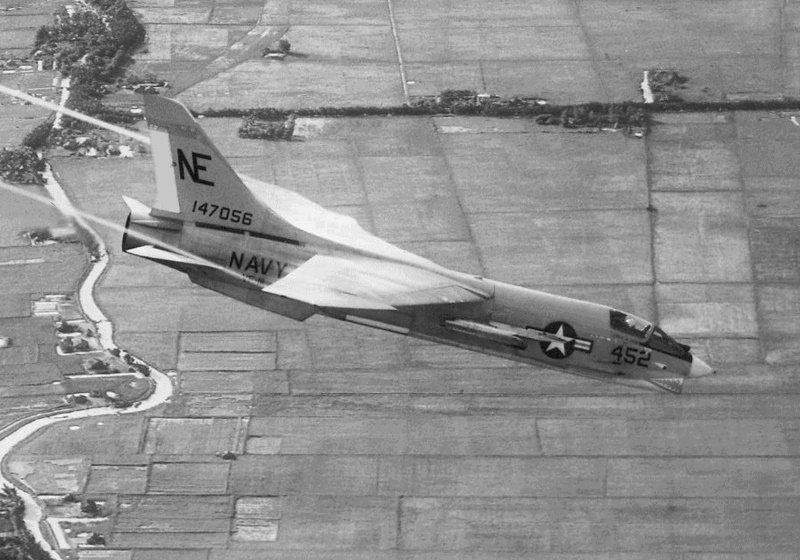
* The Crusaders weren't getting shots at MiGs because the MiGs were focused on attacking the "strike packages", and the Navy fighters were ranging free. Tactics were changed, with the fighters sticking close to the strike packages and letting the MiGs come to them.
The tactic paid off in a big-time mixup with MiGs on 12 June 1966. Commander Harold L. Marr, a long-time Navy Air man with vast experience, got into a short dogfight with a MiG-17. He fired one Sidewinder that went wide, but then got into position to send a second Sidewinder up the tailpipe of the MiG. The missile "zapped him real fine," as Marr put it, the warhead blowing off the aircraft's tail and starboard wing, sending the MiG tumbling into the ground.
Marr then bounced two MiG-17s, scoring hits on one with cannon fire until his cannons jammed due to an electrical fault. He decided to head for home. He was so excited that when he touched down the first time on the USS HANCOCK, he discovered that he hadn't extended his tailhook. He had to come back around and try again, this time landing successfully to be greeted by a wild celebration. Nobody gave him flak over the tailhook screwup.
* Nine days later, on 21 June 1966, the Crusaders mixed it up with MiGs again. Navy Crusaders were providing escort and performing reconnaissance on that day, and when an RF-8A was shot down, Crusaders vectored in on the location to provide cover for the pilot, who had ejected successfully and was waiting for a search-and-rescue (SAR) helicopter.
The Crusaders were at low altitude and low on fuel when they were bounced themselves by MiG-17s. Lieutenant Gene Chancey hit a MiG with cannon fire at close range during the mixup, tearing off his opponent's wing. However, the MiGs also scored hits on the Crusader piloted by Chancey's flight leader, Lieutenant Commander Cole Black, and Black was forced to eject.
Lieutenant JG Phil Vampatella's Crusader had been hit by flak earlier, but he was still in the fight. A MiG got stuck on his tail and Vampatella had to engage afterburner and run for it. The slower MiG broke off the attack. Even though Vampatella was low on fuel and had problems turning due to his battle damage, he decided to turn back and engage the MiG. He fired a Sidewinder that detonated behind the MiG and sent it into the ground.
Vampatella was "breathing fumes" when he managed to get a tanker on station just off the coast. However, the tanker was low on fuel too, and Vampatella was just able to make it back to his carrier, the USS HANCOCK, with no fuel to spare for a second go-round. On inspection, he discovered that his Crusader had been hit in the tail by a 37-millimeter flak round and was peppered with small shrapnel holes. Vampatella won the Navy Cross for the action.
* Unfortunately, the attempt to protect the downed Crusader pilots had failed. The SAR helicopter got lost and never showed, and both Black and the RF-8A pilot became POWs. Black was one of three Crusader pilots known to be shot down by MiGs during the war.
The second was shot down on 14 July 1966. 42-year-old Commander Rick Bellinger had been in the US Army Air Forces during World War II as a bomber pilot, and had transferred to the Navy after the war to fly combat in Korea. On 14 July, Bellinger got a MiG on his tail over Hanoi that filled his Crusader full of holes. Bellinger managed to limp offshore, but his midair refueling system was damaged, and he couldn't top off. He ejected and was rescued.
The third was lost on 5 September 1966. The Crusader's pilot, US Air Force Captain W.K. Abbott, flying Navy on an exchange program, became a POW. A fourth Crusader went down under unexplained circumstances, and its loss was credited to a MiG. All other Crusaders that went down in the war were lost to flak, SAMs, or operational accidents.
* Unlike the unfortunate Captain Abbott, Rick Bellinger had been rescued to fight another day, and on 9 October 1966 he evened the score. Four Crusaders, including Bellinger's, were escorting a strike. A Navy E-1 Tracer airborne early warning (AEW) aircraft was on station out to sea and warned the Navy pilots that MiGs were approaching.
The Crusaders took on the bandits, which turned out to be supersonic MiG-21s, new to the North Vietnamese Air Force, faster than the MiG-17 but less agile. Bellinger fired two Sidewinders at one of the MiG-21s and sent it into a rice paddy. Bellinger landed back on his carrier, the USS ORISKANY, to an excited welcome. A week later, US Secretary of Defense Robert McNamara visited the ORISKANY, and pinned the Silver Star, the customary prize for killing a MiG, on Bellinger's shirt. That was the end of the excitement for Crusader pilots for the year: they scored no more kills in 1966.
BACK_TO_TOP* The air war against North Vietnam continued to scale up in early 1967. The combat was intense, though pilots became increasingly bewildered at the logic, or lack thereof, of their missions. US President Lyndon Johnson was very worried about escalating the war, and both he and Secretary of Defense McNamara personally approved or disapproved targets on a case-by-case basis. The rules sometimes seemed to lack any rhyme or reason to the men in the shooting war. All the pilots knew for sure about was that they were getting shot at and losing friends, some killed, some taken prisoner.
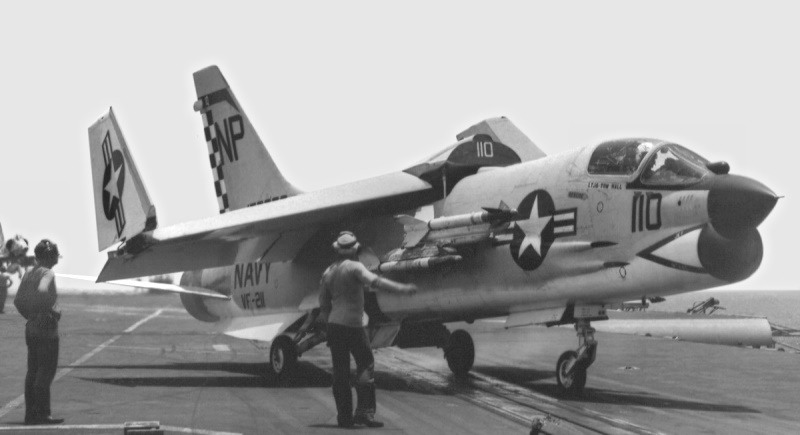
The Crusader was in the thick of the action at the time. By now, the Navy was using the Crusader mostly for the air superiority role, flying escort missions for attack aircraft. Navy Crusaders were rarely fitted with stores pylons. In contrast, the US Marines used the aircraft entirely in the strike role, supporting ground forces in South Vietnam from the air bases at Da Nang and Chu Lai. Marine Crusaders used cannon, Zuni rockets, and iron bombs attached to the stores pylons with "multiple ejector racks (MERs)". A typical Marine Crusader warload was eight Zunis on the fuselage racks and eight 225-kilogram (500-pound) Mark 82 bombs, with four on each stores pylon.
The Mark 82s were often fitted with pop-out retarding fins for low-altitude attacks -- to ensure that they fell behind the aircraft, instead of detonating underneath it -- in which case they were referred to for some obscure reason as "SnakeEyes". The Crusader could also carry two 900-kilogram (2,000-pound) Mark 84 bombs instead of the eight Mark 82s. The bombs could be fitted with standoff "daisy cutter" fuzes to increase their effectiveness against enemy forces in the open, one pilot gruesomely describing that concentrations of enemy troops struck with such weapons were "literally cut in half". The big Mark 84 bombs were also sometimes fitted with delayed-action fuzes for attacks on underground tunnel complexes; the bombs would bury themselves into the ground and then detonate, collapsing the tunnels.
Marine Crusader pilots learned how to perform precision dive-bombing attacks, dropping straight down on a target from six kilometers (20,000 feet) and then releasing their bombs at three kilometers (10,000 feet). They wanted to get their teeth into a MiG, too, but the primary reason-to-be for Marine aviation is to support the grunts in the mud, and Marine Crusader pilots never really had the opportunity to mix it up with the enemy in the sky. They hardly had an easy life of it, however, since as the war ramped up they flew more and more sorties, with enemy ground fire increasing in intensity and firepower all the time.
* That meant that the Navy Crusader pilots got most of the glory, though they increasingly had to share it with Navy F-4 Phantom pilots, leading to an intense rivalry. In the early part of the war, the Crusader was clearly the top dog. The Crusader was designed for the air-superiority mission and its pilots had been trained as dogfighters, while the Phantom was a big fighter-bomber and its pilots had been largely trained for intercept missions. Both the US Navy and Air Force would eventually form "Top Gun" flight schools to hone the skills of Phantom pilots in the art of air combat, but for the first part of the war they took back seat to the Crusader pilots.
In principle, the Crusader also had the advantage of having gun armament, while early Phantoms did not have built-in cannon. However, even though Vietnam would prove that the capabilities of US AAMs had been greatly overrated, most of the Crusader's kills were performed with AAMs, and the Crusader's cannon armament left something to be desired. Despite the fact that all four guns were focused below the cockpit, the cannon shells tended to have a wide and inaccurate dispersal pattern, and even experienced pilots with good gunnery skills found hitting anything in specific troublesome.
The ammunition supply was also regarded as too small, particularly for ground attack, since it was adequate for a total of only 13 seconds of sustained fire. A stateside Crusader squadron came up with a "fix" of sorts, wiring switches into the cockpit to allow the pilot to fire the cannon by twos. The pilot could fire both top cannon, both bottom cannon, or all four cannon at once. Firing only two cannon was an odd sort of fix, since it doubled the endurance of fire only by cutting the volume in half, but it was better than nothing. Vought endorsed the fix, though the Navy maintenance organization, naturally leery of improvisations, took some time to bless the scheme.
To make the problem worse, as Crusaders became more involved in the Vietnam air war, their ammunition supply actually shrank. To deal with the threat posed by the highly effective North Vietnamese air-defense network, in 1965 a program was pushed through to fit Crusaders with an "electronics countermeasures (ECM)" box to help deal with the radars that directed the anti-aircraft guns and SAMs. The only way to fit the ECM box into the Crusader's nose was by reducing the ammunition supply. The idea was resisted all the way up to the top, but in reality ECM was more valuable than cannon ammunition.
The worst problem with the cannons was for several reasons they tended to jam in air combat. One problem was that the spent casings were retained inside the fuselage, since they might strike the aircraft and cause damage if they were simply discarded, and sometimes the loose casings piled up and jammed the feed exits. A metal finger was added to the feed exits to make sure the casing were thrown to the rear of the bay, and this problem was resolved. A more persistent problem was that the cartridges could be jammed in the cannon feeds by high-gee maneuvers, and in addition such maneuvers could also deplete the pneumatic air supply that drove the feed mechanism. There was never really a fix for these two problems.
* In fact, although Crusader pilots were very proud of their cannon armament, as far as air combat was concerned, the day of the gun was fading. Improved aircraft performance made closing to get a "kill" with cannon fire difficult. AAMs had greater range, which not only allowed effective attacks from longer distances, but made it more difficult to close on a missile-equipped enemy who could "stand off" an opponent. Only three of the kills scored by Crusaders involved cannon fire.
To be sure, the AAMs available during the Vietnam were far from mature weapons. In the early days of the war, only one Sidewinder in eleven scored a hit. A Crusader pilot targeted his heat-seeking Sidewinder AAMs by listening to a "growl" in his headphones that rose in pitch as the missile's infrared seeker obtained a lock on the target. The heat seekers of the early Sidewinders had poor discrimination, and could be confused by sunlight or reflections of sunlight, or even by hot spots of ground. The Sidewinders also suffered from reliability problems, such as defective seekers or proximity fuzes. Sometimes electrical faults in the launch system even caused them to fire of their own accord after being armed, which could be an unpleasant situation when Crusaders were escorting a strike package.
Technical faults were addressed, if sometimes slowly, but there also was the fundamental issue of training pilots on the best use of the missiles. A pilot had to understand the missile's seeker behavior and performance envelope to have a good chance of making a "kill". The missiles weren't miraculous, and even though the Sidewinder and other AAMs would be massively improved in the following decades, they never would be miraculous. Pilots would still have to be trained how to use them.
In reality, air-to-air combat was relatively rare. The North Vietnamese Air Force never had the resources or the will to contest air superiority with the Americans, and in practice MiGs operated on an infrequent and opportunistic basis, as a backup to the heavy flak and SAM defenses that were the real threat to US aviators. At low altitude, everyone with a rifle fired on American aircraft, while at medium altitudes the aircraft were shot at with 23-millimeter, 37-millimeter, 57-millimeter, 85-millimeter, and 100-millimeter flak guns. At high altitudes, the Americans were good targets for SA-2 SAMs. It seems from a safe distance away in time and space that American pilots regarded the prospect of dogfighting with the enemy almost as a form of entertainment -- though that word doesn't seem to exactly fit a high-stakes game where the loser was likely to get killed.
* Although air-to-air combat got the glory, the photo-reconnaissance Crusaders also served a vital and often under-appreciated role. Photo-reconnaissance was unusually dangerous, particularly for "post-strike" missions where the reconnaissance aircraft flew in to determine how much damage an attack had inflicted. The enemy would always be ready and waiting. The motto of photo-reconnaissance pilots is UNARMED AND UNAFRAID. One RF-8 pilot, Lieutenant Jay Miller, commented: "Well, I sure was unarmed, but I don't know about the second part."
RF-8 pilots had a close relationship to the "photographic intelligence (PI)" teams back on the carrier, who worked with them to plan the missions and then to assess the intelligence returned by the flights. The RF-8s were always accompanied by a fighter, usually a Crusader since that meant a good performance match, to provide a second set of eyes and drive off MiGs if that became necessary. The RF-8 pilot was always in charge of the mission and called the shots, which sometimes caused friction because the fighter pilot might be much senior in rank.
* Crusaders didn't score a kill again until 1 May 1967. Lieutenant Commander Marshall O. "Moe" Wright was part of an escort of six Crusaders for A-4 Skyhawks on an "Iron Hand" flight, the dangerous job of destroying enemy air defenses ahead of a strike group. Three MiG-17s bounced the Navy aircraft.
One of the MiGs got onto the tail of an A-4, but Wright jumped the MiG in turn and blew its tail off with a Sidewinder. The pilot did not eject. Wright's wingman, Air Force Captain Ron Lord, flying on an exchange program, said afterward: "The MiG just came apart at the seams." Lord chased off a MiG later during the flight with cannon fire, scoring a few hits -- though the MiG-17 was a notoriously tough aircraft and that was unlikely to have done it much harm. Wright got a Sidewinder lock on the same bandit, but he mistakenly selected the Sidewinder he'd already launched, and the MiG got away.
Ironically, one of the Skyhawks scored a kill itself. Lieutenant Commander Ted Schwartz, who in a further twist had been a Crusader flight instructor back in the states and had trained many Crusader pilots, got his A-4C on the tail of a MiG and fired three Zuni unguided rockets at it, scoring a lucky hit and dropping the MiG out of the sky. It was the Skyhawk's only air-to-air victory of the war.
* The Crusader pilots were just getting warmed up. On 19 May, Lieutenant Phillip Wood, piloting an F-8C, was escorting Skyhawks and spotted a MiG-17 closing on a Grumman A-6 Intruder that was also participating in the strike. Wood bounced the MiG and fired a Sidewinder, but the shot was outside the missile's envelope and went wide. The missile did chase the MiG off the tail of the A-6, but another MiG got on Wood's tail in turn and hit him with cannon fire. Wood didn't appreciate this sort of treatment, got behind his attacker, and fired a Sidewinder at him. The missile put the MiG out of business; the pilot ejected, but his chute failed to open fully.
Wood was from the USS BONHOMME RICHARD, better known as the BONNY DICK, but with his battle damage he couldn't make it home and had to land on the USS KITTY HAWK instead. The A-6 had been from the KITTY HAWK and the crew let him know how much they appreciated his efforts. Wood then took a helicopter back to the BONNY DICK, where celebrations were in progress over MiG kills.
He wasn't the only BONNY DICK pilot to score a kill that day. Commander Paul H. Speer and his wingman, Lieutenant JG Joe Shea, were escorting A-4s carrying the new "Walleye" TV-guided glide bombs to strike a power plant in the middle of Hanoi. After the strike, the departing Navy aircraft were jumped by MiG-17s. Speer got into a twist-and-turn game with one and chased it down towards the ground. He fired a Sidewinder that missed, then launched a second that hit. The MiG seemed to be flying right and so Speer closed for cannon fire, but the bandit then spouted flame, flipped over, and plowed into the earth on its back.
Meanwhile, Shea was able to destroy a second MiG with a single Sidewinder. In addition, two of the carrier's F-8Cs were working over a SAM site with cannon and Zunis when a MiG-17 incautiously streaked in front of them. Lieutenant Commander Bobby Lee fired a Sidewinder, and blew the MiG in half.
* The Crusaders had another good day on 21 July. F-8s were escorting Skyhawks on a raid when they were jumped by about ten MiG-17s. Commander Marion H. "Red" Isaacks, carrying a full load of four Sidewinders on his Crusader, got behind a MiG and fired a Sidewinder. The missile lost lock and went wide. He tried again, but the second missile wouldn't light and stayed on the rack. He tried a third Sidewinder, which went right up the MiG's tailpipe, sending it up in a fireball.
The fireworks distracted Isaacks for a moment, almost a moment too long when he was jumped by a MiG that hit his Crusader with cannon fire. Isaacks turned to meet his attacker and nearly collided with him. The MiG pilot turned away and left, and Isaacks limped back to the BONNY DICK. His wing was on fire near the right aileron, but the fire went out on its own in transit.
Lieutenant Commander Robert Kirkwood had also shot a Sidewinder at a MiG, but it turned out to be the MiG that Isaacks was hunting, and the target was destroyed before Kirkwood's Sidewinder could reach it. Kirkwood picked out another MiG and fired a Sidewinder at it. The MiG pilot managed to dodge the missile warhead's blast, but fell inside the range of the Crusader's cannon. Kirkwood scored a prestigious "guns only" kill, the pilot ejecting.
Lieutenant Phil Dempewolf scored a probable kill on a MiG-17 with a Sidewinder, but Dempewolf's Crusader was jumped by two other MiGs and he was too busy to watch what happened to the target. Finally, Lieutenant Commander Tim Hubbard threw a Sidewinder, two Zunis, and for good measure cannon fire at a MiG-17, scoring a confirmed kill. The pilot also ejected.
* On 14 December a Crusader pilot, Lieutenant Commander Rich Schaffert, would earn a towering reputation among his Navy Air colleagues that day even without scoring a kill. Schaffert was flying an F-8C from the USS ORISKANY, providing escort for an A-4 piloted by Lieutenant JG Chuck Nelson on an Iron Hand mission. Schaffert's aircraft was armed with the normal four cannon and three Sidewinders, one missile having been removed before take-off when it failed preflight test.
The A-4 was preparing to attack a radar with one of its Shrike anti-radar missiles when two MiG-17s appeared to converge on the A-4. Schaffert tried to sneak up on them, but they got wise, tossed off their drop tanks, and turned to fight. As Schaffert turned to stay with them, he suddenly found two more MiG-17s attacking him from out of the Sun. Schaffert was now confronted by four MiGs, and he didn't like the odds. Unfortunately, his face mask had fallen down during his maneuvers, he couldn't spare the seconds to replace it, and so he couldn't call for help. Much to his own surprise, he managed to turn out of the attack by the second pair.
For the next ten minutes, Schaffert mixed it up with the four MiGs. He was not only badly outnumbered, the North Vietnamese pilots were clearly experienced and no pushovers. He managed to get off his three Sidewinders. The first should have been a kill but failed due to a defective proximity fuze; the second went wide; and he was too busy to watch what happened to the third. In response, two MiGs fired a total of four Atoll AAMs at him -- the Atoll was a copy of the US Sidewinder -- but they all went wide. His missiles gone, Schaffert then closed on a MiG to kill it with cannon fire. He was a good shot and felt confident, but the guns jammed due to depletion of air pressure in the pneumatic feed system from the wild maneuvers.
Now all he could do was try to survive until help arrived. Chuck Nelson was coaching Schaffert on what he could see of the situation from his Skyhawk, and other Crusaders were moving in. Three of the MiGs gradually dropped out of the fight, but Schaffert found himself engaged in a deadly confrontation with the last, performing a series of violent up and down "scissors" maneuvers to get on the other's tail. The agile MiG-17 was slowly gaining the advantage, so Schaffert decided to bug out: the Crusader's superior speed meant that he had the option of making or breaking combat. At the top of the sixth scissors, he pointed his nose down, engaged afterburner, and left the slower MiG behind, pulling out of his high-speed dive just skimming the treetops.
Schaffert got his Crusader back to the ORISKANY with too little fuel to perform a second go-round. While weapon failures had cheated him of any kills, his duel had lasted an adrenalin-drenched 10 minutes 45 seconds, an eternity in a high-speed dogfight. He had simply outflown his adversaries and became a legend among Navy fighter jocks.
The MiGs didn't get away unscathed that day, however. While Schaffert was trying to stay alive, several other Crusaders had jumped into the fight, which became a wild mixup. Lieutenant Richard Wyman found himself on the tail of a MiG-17, with the two aircraft streaking over the treetops. Wyman launched a Sidewinder and scored a hit, later recalling: "The wing fell off. Red fire streaked along the side of the aircraft as it cartwheeled into a rice paddy."
Another Crusader pilot who was in the same fight, Commander Cal Swanson, gave the North Vietnamese pilot an admiring obituary, in a conflict where such sentiments were scarce: "That was probably the longest MiG engagement of the war. That MiG pilot was a tiger. He came to fight."
BACK_TO_TOP* The Crusaders didn't score another kill until 26 June 1968. A MiG-21 made a head-on pass at three Crusaders, and one of the Navy pilots, Commander Lowell R. "Moose" Myers, yanked his F-8H around and put a Sidewinder into the MiG, blowing its tail off. Myers called the kill "the biggest thrill of my life."
On 9 July 1968, Lieutenant Commander John B. Nichols III was "riding shotgun" for an RF-8 on a low-level reconnaissance mission when they were bounced by two MiG-17s. Nichols fired a Sidewinder at one that missed, but scared the pilot into his sights, and the North Vietnamese pilot then engaged afterburner that made him a perfect target for another missile. Nichols' second Sidewinder scored a direct hit. To Nichols' amazement, the MiG stayed in the air, a testimony to its rugged construction. Nichols finished it off with cannon fire; it crashed with its pilot still on board.
Nichols was fired on by a second MiG during his attack, but failed to engage it. He attributed his kill less to his own skill than the inexperience of the North Vietnamese pilot. Intelligence described the pilot as 23 years old and with 450 hours of flight time. "He flew like it," Nichols commented.
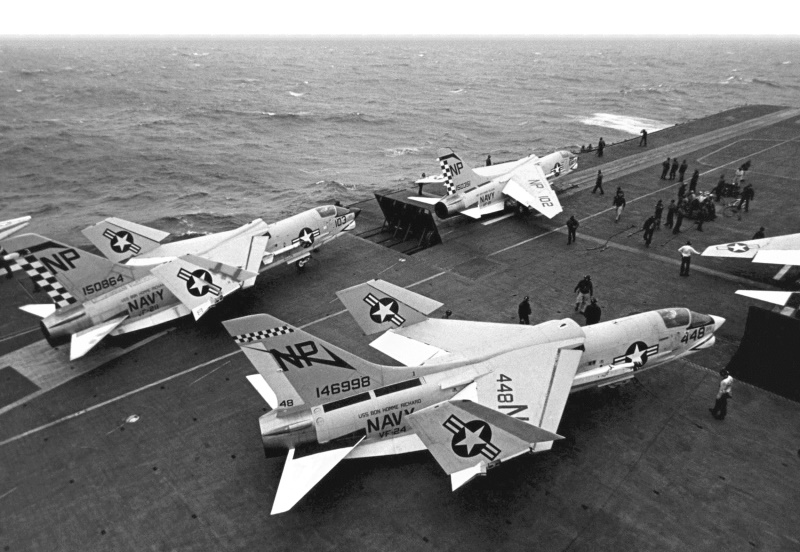
On 27 July 1968, four F-8Es fought it out with four MiG-17s, and Commander Guy Cane hit one with a Sidewinder. He thought he'd missed until he saw part of the MiG's wing come off, and the North Vietnamese aircraft then spiraled into the ground.
On 1 August 1968, two Crusaders, piloted by Lieutenant George Hise and Lieutenant Norm McCoy, were vectored against a bandit picked up on radar by a Navy vessel offshore. It turned out to be a MiG-21 that fired on them with an Atoll. The missile went wide, and Hise got into position to retaliate with his own missile. He believed he scored a hit, but the MiG disappeared into a cloud. McCoy spotted the MiG-21 again a minute later and hit it with another Sidewinder; he chased it down to the ground to confirm the kill even though he was dangerously low on fuel. He managed to hook up with a tanker out at sea and make it home. McCoy was credited with the kill.
On 19 September 1968, two F-8Cs were on combat air patrol when they were vectored to a pair of bandits. The Navy pilots climbed to meet them and ran into two MiG-21s. Lieutenant Anthony G. Nargi fired a Sidewinder that blew the tail off one of the MiG-21s, the pilot ejecting. Both Navy pilots fired a Sidewinder at the second MiG-21; one missile exploded close by the target, but the North Vietnamese pilot zoomed away to safety.
* That was the last aircraft to be shot down by a Crusader for the rest of the aircraft's life, though the F-8 was credited with one more kill. On 22 April 1972, two F-8Js found a MiG-17 and tried to sneak up on it for a Sidewinder shot. The North Vietnamese pilot, apparently inexperienced, simply ejected safely, and his aircraft plowed into the ground. It might not have been much of a kill, but it was still a kill.
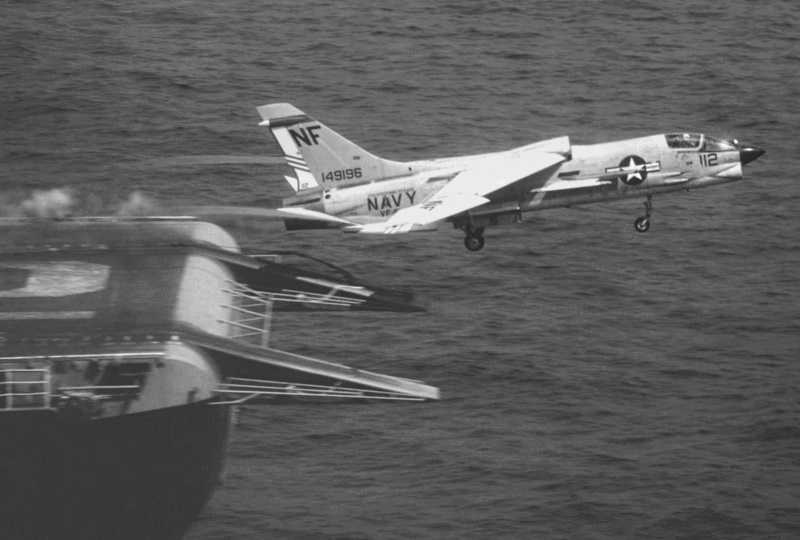
Not counting that farce, the final tally of MiG kills for the Crusader was 18, compared to losses of four Crusaders to MiGs. Navy Phantoms eventually well exceeded this score, with 36 kills, with losses of six Phantoms to MiGs. The real enemy of the Crusader was flak and SAMs. The final tally of Crusader losses in Southeast Asia was:
About 13% of all Crusaders built were lost. Interestingly, 76 of the 166 losses, almost half of the total, were due to accidents, not direct enemy action. That is not too unusual for combat flight operations, particularly since combat sorties sometimes have to be conducted in weather when "even the birds were grounded" -- demonstrating that it was almost as unsafe just to fly aircraft under such conditions as it was to deal with the efforts of the Black Hats to shoot them down.
BACK_TO_TOP* The Vietnam War was the high tide of the Crusader. By 1972, the fighter versions of the F-8 were being phased out of service, having been replaced by their rival, the F-4. The last Crusader fighter in first-line service was retired to the "boneyard" at Davis-Monthan Air Force Base in Arizona in May 1976.
The RF-8Gs soldiered on through the 1970s, and in fact they were updated with the more powerful J57-P-420 engine of the F-8J. This "Power Eye" modification provided a third more thrust, and also included other changes, such as an improved ECM suite. In the postwar period, they were given an overall dove-gray color scheme, and in their last years featured a two-tone scheme of pale grays. The RF-8G was finally phased out in the early 1980s, with the last one in front-line service flying off to Davis-Monthan in late May 1982. The RF-8G lingered in Navy Reserve operations for a bit longer, finally being retired at the end of March 1987.
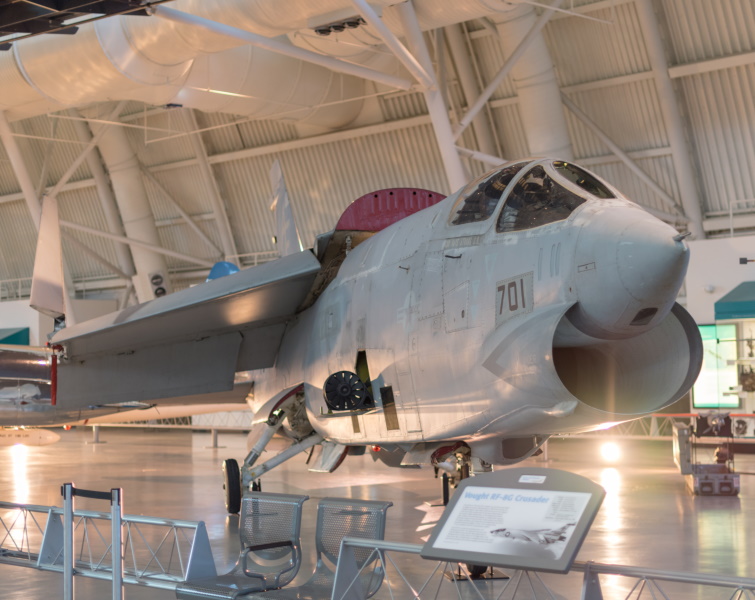
In fleet service, reconnaissance duties were to be taken up by the F-14 Tomcat with the "TARPS" reconnaissance pod. That was not a perfectly adequate replacement for a dedicated reconnaissance aircraft, all the more so because fighter pilots didn't like the idea of being pressed into service for the reconnaissance mission. However, the Navy no longer felt they could afford dedicated reconnaissance aircraft. Adjusting to the new realities took time.
* The Crusader lived on in foreign service. In 1977, 25 refurbished US Navy F-8Hs were sold at a bargain price to the Philippine Air Force as "F-8Ps", along with ten other aircraft used for spares. The last Philippine Crusaders were finally withdrawn from service in 1991.
The Aeronavale Crusaders were the last of the breed in military service. Between 1991 and 1994, 17 of the F-8E(FN)s were rebuilt to extend their operational life, partly with kit taken from F-8Js stored in the Davis-Monthan boneyard. The updated Crusaders were, confusingly, also designated "F-8P" (for "Prolonge"), and incorporated a few modest avionics updates -- most visibly the antennas for a Thomson-CSF SHERLOC radar warning receiver added to the upper tail. By that time, they were painted in a distinctive dark slate-gray color scheme with small national insignia, which was judged more effective camouflage in the gloomy North Atlantic environment.
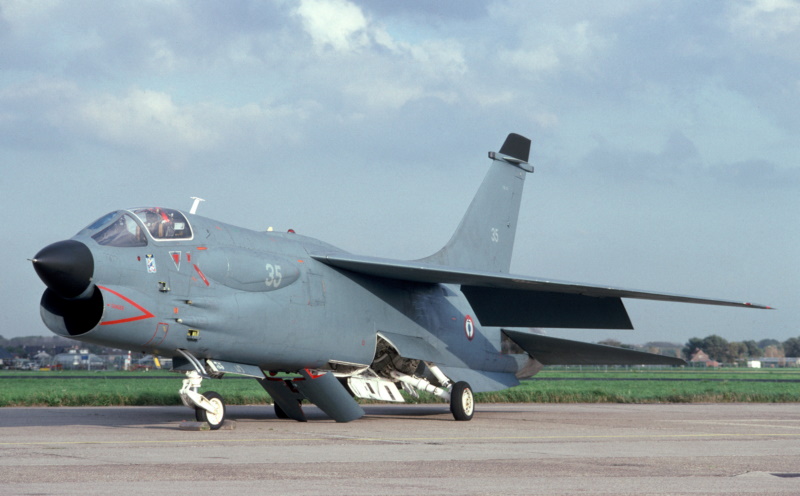
While the French Crusaders did operate over Lebanon in 1983 as escorts for Super Etendards, they did not accompany the CLEMENCEAU to the Gulf War in 1991. Five of the 42 Aeronavale Crusaders survived long enough to be the last Crusaders retired from military service, in December 1999. Although they had given decades of excellent service, by that time they were regarded as so ill-suited to modern combat operations that they were not even assigned missions in the Kosovo air campaign in the spring of 1999.
* A number of Crusaders ended up flying in civilian colors. In 1987, Thunderbird Aviation of Phoenix, Arizona, flew a unique demilitarized Crusader that was mostly a hybrid of an F-8K and an F-8L, with bits and pieces scrounged up from other aircraft. Most military equipment was removed and some features were added, such as a camera system for test flight duties and modern (civilian) avionics. Thunderbird introduced a second civilianized Crusader in 1989.
The two Crusaders eventually ended up being purchased by Microsoft vice-president Paul Allen, a dedicated aircraft collector with very deep pockets. Rockwell International also obtained two RF-8Gs for use as chase planes in 1984, but these two aircraft were finally grounded in 1992. A good number of Crusaders survive as static displays.
BACK_TO_TOP* There were some unusual modifications of the Crusader for experimental purposes. A number of F-8As were modified as target drone controllers in the late 1960s, with designations such as "DF-8A", "QF-8A", and "DQF-8A". They were painted in gaudy color schemes, such as a dark blue body and bright yellow and red wings and tail surfaces, to make them conspicuous lest they become targets themselves. The exact configuration and usage of these aircraft is unclear, but they were at least in part used to control and chase "Regulus II" missiles, which were supersonic sea-launched cruise missiles that, failing to go into operational service, had been converted to targets.
In 1957, Vought experimentally fitted two F8U-1s with an auxiliary rocket engine in the tail above the tailpipe to give them a faster rate of climb for high-altitude intercepts. A Reaction Motors XLF-40 rocket engine was considered at first. The XLF-40 burned jet fuel and hydrogen peroxide and could generate an additional burst of 35.6 kN (3,630 kgp / 8,000 lbf) of thrust. Unfortunately, one XLF-40 blew up during a static test, killing two Reaction Motors workers; the company dropped out of the project before anyone else got hurt.
Vought continued the program for a while longer, focusing on the Rocketdyne XLF-54 rocket engine. None of the rocket-boosted Crusaders ever flew, though the two aircraft were fitted with dummy engines to validate the engine fit. The reasons why the project was abandoned are unclear, but the caustic and toxic nature of hydrogen peroxide probably had a lot to do with it: the Navy does not like storing such hazards on a ship.
Vought also proposed modifying the Crusader so that in an emergency the entire nose could break off and be used as an escape capsule, with the capsule using three parachutes to make a soft landing. Details of this scheme are unclear as well, except for the fact that it never happened. Escape capsules were a fashionable idea in the 50s and 60s, but they weren't easy to implement; they required a lot of parachute canopy to ensure that the landing didn't kill the crew, and they also had stabilization problems. The ultimate decision was that conventional ejection seats were a better idea.
* NASA employed two Crusaders as experimental vehicles. In 1971, an F-8A was modified to test an unusual new "supercritical" wing design, with the aircraft not only fitted with the new wing, but also with "cheek" fairings to modify its area-ruling. Ventral fins were not added. The blue-&-white NASA Crusader flew test flights into 1973 and was then retired. It is now on display at the NASA Dryden Center's flight test facility at Edwards AFB in California.
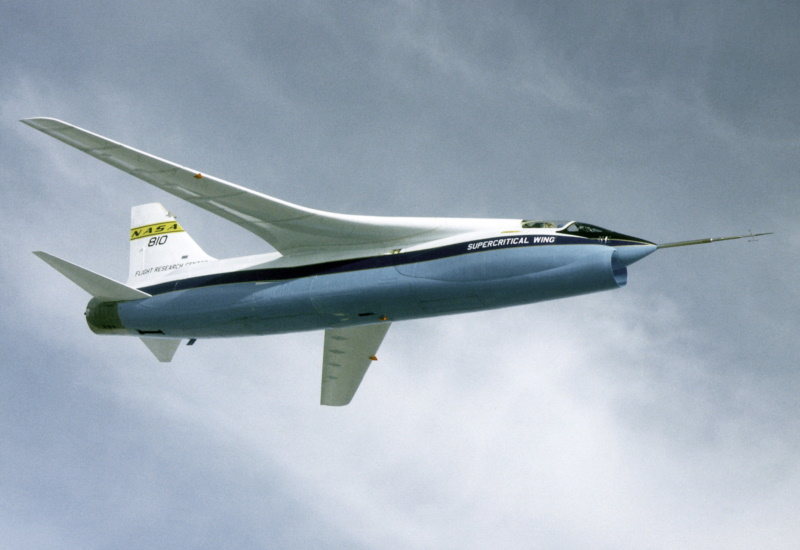
NASA also used an F-8C, with the NASA tailcode "802", for a number of flight experiments, including digital flight control systems and simulations of space shuttle handling. In the early 1980s, there was some discussion of fitting NASA 802 with an experimental "slew wing", an elliptical wing that could pivot to an angle relative to the aircraft's fuselage, but it didn't happen.
* The most interesting Crusader offshoot was the "XF8U-3 Crusader III", which was really an entirely new aircraft with no more than a conceptual relationship to the original Crusader design. While the F8U-3 had a clear resemblance to its ancestor, it was a much more rakish machine, with a barracuda-like nose and large ventral fins that folded horizontally for take-off and landing. It was also bigger and more muscular in appearance than the Crusader.
The XF8U-3 was conceived in 1955 as a high-performance interceptor, and was designed in competition with the McDonnell F4H-1 Phantom. The first example was flown in June 1958 with John Konrad at the controls, being powered by a Pratt & Whitney J75-P-5A turbojet with 73.4 kN (7,480 kgp / 16,500 lbf) dry thrust and 131.2 kN (13,380 kgp / 29,500 lbf) afterburning thrust. Performance and handling were judged as excellent. The test pilots also appreciated the aircraft's advanced avionics, including an experimental "head-up display", and its very roomy cockpit.
Initially, the XF8U-3 was to be armed only with three Sparrow III missiles, though an alternate armament of four Sidewinders was contemplated later. No cannon armament was ever considered. The wing was fitted with a drooping leading edge, along with long-extension flaps, and a BLC system was incorporated to improve landing characteristics.
___________________________________________________________________
CHANCE-VOUGHT XF8U-3 CRUSADER III:
___________________________________________________________________
wingspan:
12.16 meters (39 feet 11 inches)
wing area:
41.80 sq_meters (450 sq_feet)
length:
17.88 meters (58 feet 8 inches)
height:
4.98 meters (16 feet 4 inches)
empty weight:
9,920 kilograms (21,860 pounds)
loaded weight:
17,590 kilograms (38,770 pounds)
max speed at altitude:
2,350 KPH (1,460 MPH / 1,270 KT)
range:
3,290 kilometers (2,050 MI / 1,780 NMI)
___________________________________________________________________
Vought received an initial contract for two XF8U-3s in May 1957, followed by a second contract for 16 evaluation aircraft, but only three Crusader IIIs were completed. The Navy selected the Phantom and canceled the contract with Vought in December 1958. The Crusader III had potential, but the Navy preferred the two-seat, twin-engine configuration of the Phantom. Test flights were terminated after the aircraft had demonstrated a speed of Mach 2.3. Vought believed the aircraft was capable of Mach 2.9, but the windscreen material wasn't up to that kind of punishment, and the program was killed before Vought could make the necessary changes. Two XF8U-3s were passed on to NASA for high-altitude and sonic boom flight tests, while the third was sent to Edwards Air Force Base for flight testing. They were all scrapped after a year or two.
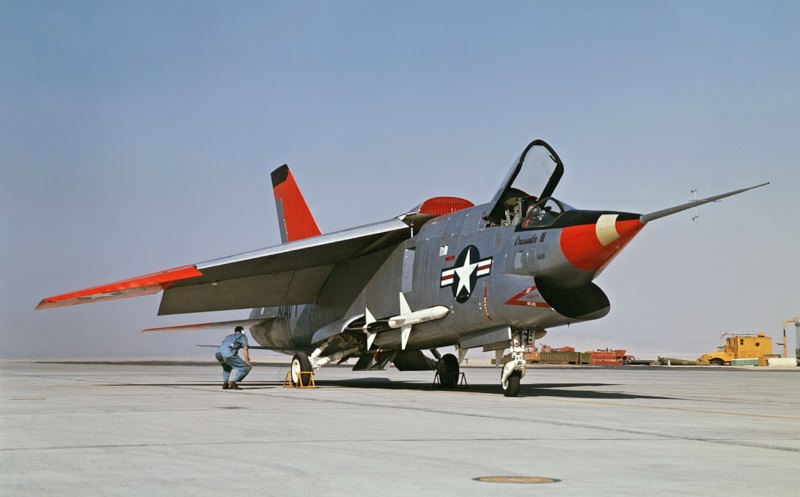
There are stories that NASA pilots flying out of the agency's center at Langley, Virginia, liked to go up to the Navy air test center at Patuxent River, Maryland, with their Crusader IIIs and bounce Phantoms. Navy test pilots complained -- they were trying to get a job done, after all -- and the NASA pilots were told to knock it off.
BACK_TO_TOP* The operational history of the F-8 Crusader has an interesting distinction. In August 1960, a US Navy pilot took off from Naples, Italy, and climbed to about 1,500 meters (5,000 feet). When he leveled off, he found he was exerting an unusual amount of pressure on the stick. Looking around for the cause, he discovered that he hadn't unfolded his wings! The pilot was obviously cool-headed, since he decided to investigate how the aircraft handled in this configuration while he dumped what fuel he could. After about 24 minutes of flight, he came back in for a landing, which was fast but otherwise uneventful. He reported no particular problems flying the aircraft. Vought engineers were very pleased when they heard the story, though Navy brass were far from happy with the incident.
This is said to be the first case where an aircraft took off with folded wings and safely landed again, but Crusaders took off with folded wings at least seven more times afterward. Unsurprisingly, it usually happened at night. One pilot managed to waggle the aircraft and get the wings back down in flight. In response to the posting of an early version of this document on the internet, the executive officer of the French Aeronavale squadron operating the Crusader, Antoine Guillot, said one of his pilots had pulled the same trick at an airshow in Belgium. Under such circumstances, the pilot might have been able to claim he did it on purpose, as a stunt.
Another interesting tale about the Crusader is of the one that visited Miramar NAS, near San Diego, California. The unnamed pilot, who had killed a MiG in Vietnam, was noted for "colorful" behavior. He taxied up to the fuel pit to top off his tanks, but nobody came out to give him service. He got tired of waiting and taxied up to the line shack, but nobody inside noticed of the rumbling fighter outside. His patience finally snapped; he was right alongside the line shack and extended his flight refueling probe, smashing it through the window, and finally got a response.
Yet another story is that of a student pilot who was practicing arrested landings on a land runway with an F-8H. Things didn't go well, with the pilot missing the cables on two attempts. As he came around for the third attempt, the pilot decided that his aircraft wasn't flying any more, and ejected. The pilotless aircraft then settled down on the runway and snagged the cable, to come to rest alongside the runway with minor damage.
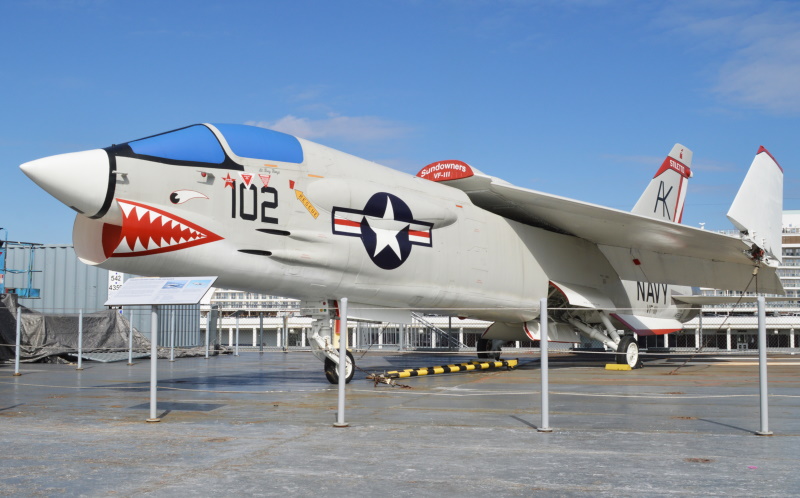
* Sources for this document include:
* Illustrations details:
* Revision history:
v1.0 / 01 jan 98 v1.1 / 15 jan 98 / Minor corrections. v2.0 / 01 aug 01 / Major update & rewrite. v2.0.1 / 01 mar 02 / Review & polish. v2.0.2 / 01 mar 04 / Review & polish. v2.0.3 / 01 mar 06 / Review & polish. v2.0.4 / 01 feb 08 / Review & polish. v2.0.5 / 01 jan 10 / Review & polish. v2.0.6 / 01 dec 11 / Review & polish. v2.0.7 / 01 nov 13 / Review & polish. v2.0.8 / 01 dec 14 / Review & polish. v2.0.9 / 01 nov 16 / Review & polish. v2.1.0 / 01 dec 18 / Review & polish. v2.2.0 / 01 oct 20 / Illustrations update. v2.2.1 / 01 jun 21 / Clean-up, more illustrations. v2.2.2 / 01 apr 23 / Review & polish. v2.2.3 / 01 mar 25 / Review & polish. (++)BACK_TO_TOP
